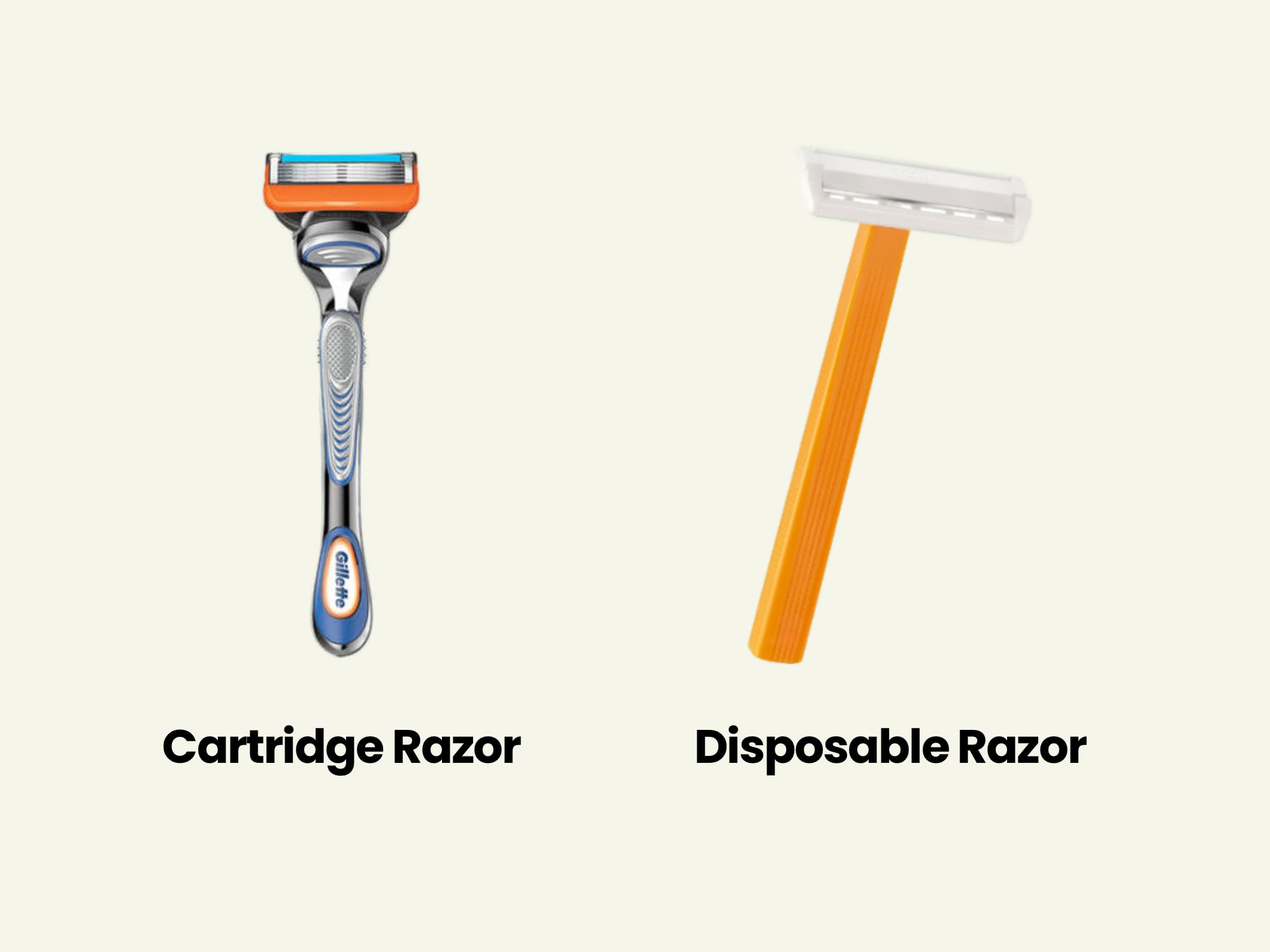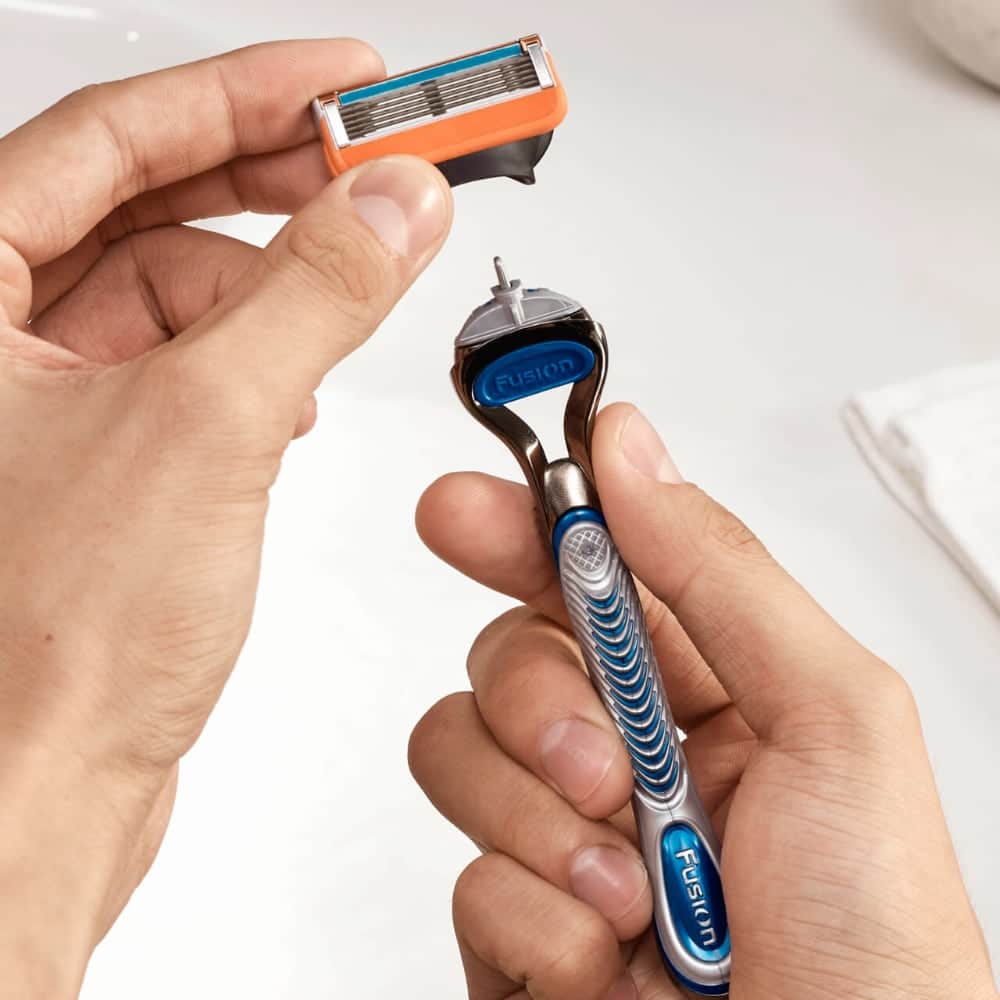While they may seem identical at first, cartridge razors and disposable razors are different in many ways. The most notable difference is that cartridge razors have interchangeable blades, whereas disposable razors do not.
However, as with all shaving tools, nuances in the design and shave quality are also quite different.
We will compare both these razors so you can learn how they impact your shave.
Comparison Table
Here’s a table that compares all the key differences in features between cartridge razors and disposable razors:
| Feature | Disposable Razors | Cartridge Razors |
|---|---|---|
| Interchangeable blades | No | Yes |
| Weight | Light | Heavier |
| Grip | Standard | Ergonomic |
| Blade Count | 1-3 | 4-7 |
| Pivot | Yes | Yes |
| Tilt | No | Yes |
| Precision trimmer | No | Yes |
| Shave Quality | Not as close | Closer and smoother |
| Blade Quality | Standard | Enhanced coating |
| Number of Shaves | 10 | 15-20 |
| Cost | $1.25 per razor | $3.75 per razor |
| Environmental Impact | Not eco-friendly | Better, but still not eco-friendly |
Interchangeable blades vs. fixed blades
Cartridge razors get their name because the blades they rely on are in a cartridge form. Meaning that when the blades eventually dull, you can swap them with a fresh edge while still using the same handle.
As the name suggests, disposable razors can only be used until the blade is dull. Once this happens, the entire razor must be thrown away.
Other design similarities and differences

Here are some of the more nuanced similarities and differences between both these razors:
Similarities
- Pivot head: This allows the blades to move with the contours of your face, ensuring that you get both close and consistent shaves.
- Lubricating strip: At the top of the blades, the lubricating strip helps to reduce post-shave irritation. They often contain skin anti-inflammatory ingredients such as aloe vera and vitamin E.
- Handle: Both cartridge and disposable razors have handles that are designed to fit comfortably in your hand. This allows you to have more control over the razor and get a closer shave.
- Guard bar: Before the hair meets the blade, the guard bar flattens the skin to reduce nicks and cuts.
Differences
- Weight: Cartridge razors are generally heavier than disposable razors. For example, a Gillette Fusion ProGlide weighs 1.69oz (48g), while a Bic disposable razor weighs 0.31oz (9g).
- Grip: Given that cartridge razor handles are intended to be used multiple times, they often have a more ergonomic and non-slip grip.
- Blade count: While both systems may have multiple blades, cartridge razors generally skew higher (4 to 7 blades), whereas disposable razors generally have 1 to 3 blades.
- Tilt: Some cartridge razors have a tilt head, making it easier to shave curved surfaces such as your neck, head, chin, and jawline.
- Precision trimmer: On the back of the cartridge, some razors have a single blade that can be used to trim your sideburns, mustache, and beard.
- Power function: Some cartridge razors have a vibrating power function that helps to raise the hairs to get a closer shave.
- Heated blades: For those that want a hot-towel like shave, the Gillette Heated Razor is a cartridge razor that heats up the blades to soothe your skin.
Shave quality

Many factors go into the quality of your shave, including technique, shaving cream, and hair type. When all these factors are equal, cartridge razors provide a smoother and closer shave than disposable razors. This is largely due to the increase in pressure applied by the extra weight within the handle, along with the increased number of blades.
Other details, like the tilt head and larger lubricating strip found in cartridge razors, only help to improve the shave quality.
Without adequate prep, disposable razors can be quite painful and leave a lot of irritation. Additionally, most folks may require multiple passes to get a shave that is as close as a cartridge razor.
Blade quality
Both cartridge and disposable razors will rely on stainless steel blades. However, companies like Gillette may add an anti-friction coating to their cartridge razor blades that help to reduce irritation.
Number of shaves

Like shave quality, the number of shaves you can get from a razor will depend on several factors.
Companies may market that their disposable razor can last up to 10 shaves, but in reality, it is likely half that. The same goes for cartridge razors, which may last up to a month, but you can expect about 15 to 20 shaves before the blades become noticeably dull.
Cost
When comparing cartridge and disposable razors head-to-head, disposable razors are generally cheaper. You can often find a pack of 8 disposable razors for about $10, which equates to roughly $1.25 per razor.
Conversely, cartridge razors will cost about $30 for a pack of 8 blades, which rings up to $3.75 per razor.
Environmental impact
Both cartridge and disposable razors are not environmentally friendly as they add unnecessary plastic to landfills. If you want a more eco-friendly option, you can opt for a safety razor.
We highlight all the other types of razors if you want to learn more.
That being said, cartridge razors are better for the environment as only the cartridge head is thrown away rather than the entire razor. Eco-conscious consumers may want to look into having their used cartridges recycled through local collection programs like TerraCycle.